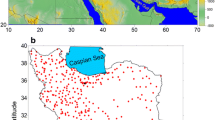Summary
The study addresses some methodological issues of application of principal component analysis (PCA) to the classification of circulation patterns. The obliquely rotated PCA in T-mode (i.e. with time observations corresponding to variables and grid points to realizations) is applied to 500 hPa geopotential heights over Europe and adjacent parts of Atlantic Ocean. The solutions are examined for various numbers of principal components rotated, and for both raw and anomaly data, with the aim to find the way of determining the optimum number of circulation types. This is done, among others, by examining temporal and spatial stability of solutions, their compliance with simple structure requirements, and temporal behaviour of classifications. Some of the solutions that are pre-selected according to the rule based upon the separation between successive eigenvalues prove to perform considerably better than unselected ones; some of them do not. Which pre-selected solutions should be given preference is impossible to decide in advance, without a detailed scrutiny. Nevertheless, even after such a scrutiny is done, more than a single classification are acceptable. The final choice of the optimum solution depends on the aims of the intended study: It should balance the demands on statistical stability of types and on resemblance between types and daily patterns classified with them.
Similar content being viewed by others
References
Cohen, S. J., 1983: Classification of 500 mb height anomalies using obliquely rotated principal components.J. Climate Appl. Meteor.,22, 1975–1988.
Compagnucci, R. H., Ruiz, N. E., 1992: On the interpretation of principal component analysis as applied to meteorological data.Fifth Int. Meeting on Statistical Climatology, Toronto, 241–244.
Compagnucci, R. H., Vargas, W. M., 1986: Patterns of surface pressure field during July 1972–1983 in southern South America and the Antarctic peninsula.Third Int. Conference on Statistical Climatology, Vienna.
Drosdowsky, W., 1993: An analysis of Australian seasonal rainfall anomalies: 1950–1987. I: Spatial patterns.Int. J. Climatol.,13, 1–30.
Ehrendorfer, M., 1987: A regionalization of Austria's precipitation climate using principal component analysis.J. Climatol.,7, 71–89.
Harman, H. H., 1976:Modern Factor Analysis. Chicago. University of Chicago Press, 487 pp.
Hess, P., Brezowsky, H., 1952: Katalog der Grosswetterlagen Europas.Ber. Dtsch. Wetterdienstes, US-Zone,3, 3–39.
Hewitson, B. C., Crane, R. G., 1992: Regional climates in the GISS global circulation model: Synoptic-scale circulation.J. Climate,5, 1002–1011.
Huth, R., 1993: An example of using obliquely rotated principal components to detect circulation types over Europe.Meteorol. Z., N. F.,2, 285–293.
Huth, R., 1996: An intercomparison of computer-assisted circulation classification methods.Int. J. Climatol. (accepted)
Key, J., Crane, R. G., 1986: A comparison of synoptic classification schemes based on ‘objective’ procedures.J. Climatol.,6, 375–388.
Kimoto, M., Ghil, M., 1993a: Multiple flow regimes in the Northern Hemisphere winter. Part I: Methodology and hemispheric regimes.J. Atmos. Sci.,50, 2625–2643.
Kimoto, M., Ghil, M., 1993b: Multiple flow regimes in the Northern Hemisphere winter. Part II: Sectorial regimes and preferred transitions.J. Atmos. Sci.,50, 2645–2673.
Kirchhofer, W., 1973: Classification of 500 mb patterns. Arbeitsbericht der Schweizerischen Meteorologischen Zentralanstalt 45.
Lamb, H. H., 1972: British Isles weather types and a register of the dail sequence of circulation patterns 1861–1971.Geophys. Mem.,116, HMSO London, 85 pp.
Legates, D. R., 1993: The effect of domain shape on principal component analyses: A reply.Int. J. Climatol.,13, 219–228.
Lund, I. A., 1963: Map-pattern classification by statistical methods.J. Appl. Meteor. 2, 56–65.
Lyons, W. F., Bonell, M., 1994: Regionalization of daily mesoscale rainfall in the tropical wet/dry climate of the Townsville area of north-east Queensland during the 1988–1989 wet season.Int. J. Climatol.,14, 135–163.
Morrison, D. F., 1976:Multivariate Statistical Methods. New York: McGraw-Hill, 415 pp.
North, G. R., Bell, T. L., Cahalan, R. F., Moeng, F. J., 1982: Sampling errors in the estimation of empirical orthogonal functions.Mon. Wea. Rev.,110 699–706.
O'Lenic, E. A., Livezey, R. E., 1988: Practical considerations in the use of rotated principal component analysis (RPCA) in diagnostic studies of upper-air height fields.Mon. Wea. Rev.,116, 1682–1689.
Preisendorfer, R. W., 1988:Principal Components Analysis in Meteorology and Oceanography. Amsterdam, New York, Tokyo: Elsevier, 425 pp.
Richman, M. B., 1981: Obliquely rotated principal components: An improved meteorological map typing technique?J. Appl. Meteor.,20, 1145–1159.
Richman, M. B., 1986: Rotation of principal components.J. Climatol.,6, 293–335.
Richman, M. B., Angel, J. R., Gong, X. 1992: Determination of dimensionality in eigenanalysis.Fifth Int. Meeting on Statistical Climatology, Toronto, 229–235.
Toth, Z., 1993: Preferred and unpreferred circulation types in the Northern Hemisphere wintertime phase space.J. Atmos. Sci.,50, 2868–2888.
van den Dool, H. M., 1991: Mirror images of atmospheric flow.Mon. Wea. Rev.,119, 2095–2106.
White, D., Richman, M., Yarnal, B., 1991: Climate regionalization and rotation of principal components.Int. J. Climatol. 11, 1–25.
Author information
Authors and Affiliations
Additional information
With 6 Figures
Rights and permissions
About this article
Cite this article
Huth, R. Properties of the circulation classification scheme based on the rotated principal component analysis. Meteorl. Atmos. Phys. 59, 217–233 (1996). https://doi.org/10.1007/BF01030145
Received:
Revised:
Issue Date:
DOI: https://doi.org/10.1007/BF01030145




